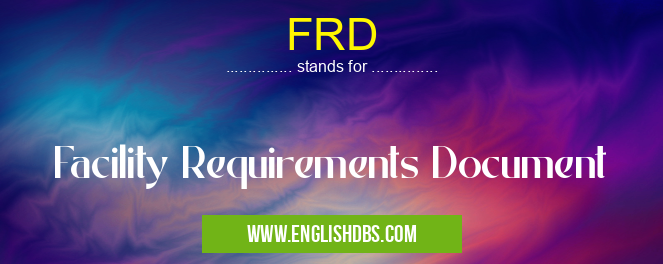What does FRD mean in UNCLASSIFIED
FRD stands for Facility Requirements Document, which serves as a comprehensive blueprint for the design, construction, and operation of a facility. It outlines the specific requirements, specifications, and guidelines that must be met to ensure the facility meets its intended purpose and complies with applicable regulations.

FRD meaning in Unclassified in Miscellaneous
FRD mostly used in an acronym Unclassified in Category Miscellaneous that means Facility Requirements Document
Shorthand: FRD,
Full Form: Facility Requirements Document
For more information of "Facility Requirements Document", see the section below.
Key Elements of a FRD
- Project Overview: Provides background information on the project, including its objectives, scope, and timeline.
- Facility Description: Describes the physical characteristics of the facility, including its size, layout, and any specialized areas or equipment.
- Functional Requirements: Outlines the specific functions and activities that the facility must support, such as manufacturing processes, research labs, or medical treatments.
- Environmental Requirements: Specifies the environmental conditions that must be maintained within the facility, such as temperature, humidity, and air quality.
- Safety and Security Requirements: Details the safety and security measures that must be implemented, including fire protection, access control, and hazardous materials handling.
- Regulatory Compliance: Identifies all applicable regulations, codes, and standards that the facility must comply with.
- Quality Assurance: Outlines the quality assurance procedures and protocols that must be followed throughout the design, construction, and operation of the facility.
Benefits of a FRD
- Clear Communication: Ensures that all stakeholders have a clear understanding of the facility's requirements.
- Efficient Design and Construction: Provides a roadmap for the design and construction process, reducing delays and costly rework.
- Compliance with Regulations: Helps ensure that the facility meets all applicable regulations and industry standards.
- Improved Facility Performance: Defines the operating parameters and maintenance requirements necessary for optimal facility performance.
- Long-Term Planning: Serves as a foundation for ongoing facility management and expansion planning.
Essential Questions and Answers on Facility Requirements Document in "MISCELLANEOUS»UNFILED"
What is the purpose of a Facility Requirements Document (FRD)?
An FRD is a critical document that outlines the functional, spatial, and technical requirements for a facility. It serves as a baseline for design, construction, and operation, ensuring that the facility meets the specific needs of the organization.
What are the key components of an FRD?
An FRD typically includes sections that address: project overview, user needs, space requirements, environmental considerations, security and safety requirements, sustainability goals, and project schedule.
Who is responsible for developing an FRD?
The responsibility for developing an FRD typically falls on a project team that includes representatives from the organization, architects, engineers, and other stakeholders.
What are the benefits of using an FRD?
An FRD provides numerous benefits, including: clear communication of project requirements, improved coordination between stakeholders, reduced risk of design errors, streamlined construction process, and enhanced facility functionality.
When is the best time to develop an FRD?
It is recommended to develop an FRD early in the project planning phase, before design and construction commence. This allows for thorough requirements gathering and analysis, ensuring that the facility meets the organization's current and future needs.
What are some common challenges in developing an FRD?
Some common challenges include: gathering accurate user needs, accommodating conflicting requirements, managing stakeholder expectations, and balancing budget and functional constraints.
How can I ensure an effective FRD?
To ensure an effective FRD, it is crucial to involve stakeholders, conduct thorough research, define clear requirements, use precise language, and regularly review and update the document throughout the project lifecycle.
Final Words: A Facility Requirements Document is a critical tool for ensuring the successful planning, design, construction, and operation of any facility. By clearly defining the requirements and specifications, it helps stakeholders collaborate effectively and ensures that the facility meets its intended purpose.
FRD also stands for: |
|
| All stands for FRD |
